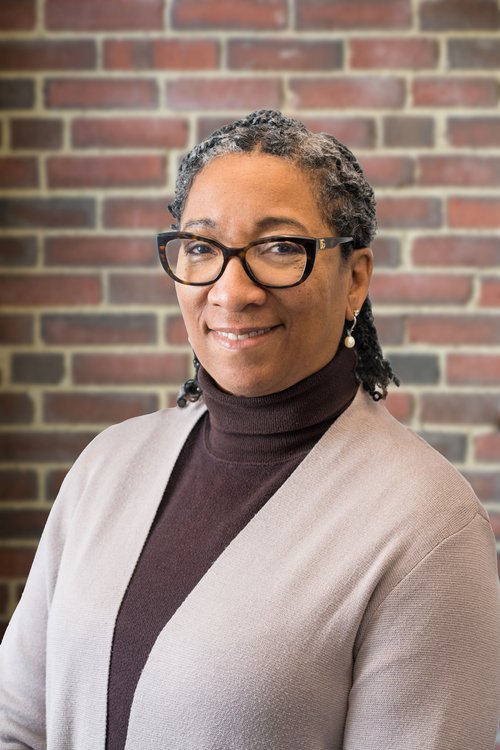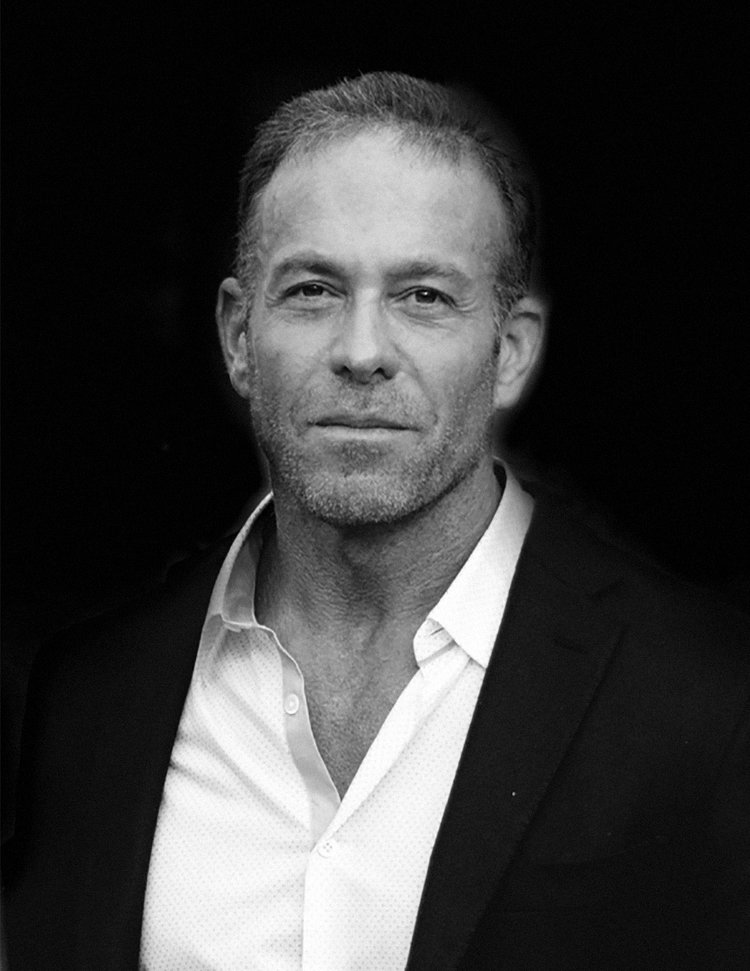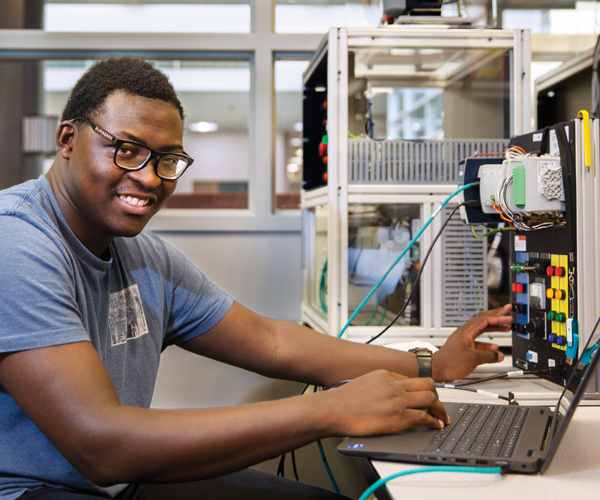Baldwin Wallace Steps Up to the Plate
by Bob Sandrick | Feb. 1, 2022 | 5:00 AM

Terrell McDowell is thinking about things he never thought of before. The Baldwin Wallace University senior wonders how much food is thrown out by vendors at Cleveland Browns stadium and how many homeless people just outside the stadium could use that food.
McDowell started weighing such matters after he helped create Campus Plate, an app that allows Baldwin Wallace students who are food-insecure learn where they can pick up free, leftover meals on campus. The app is available for both Android and Apple phones.
“I’ve always been a caring person, but the Campus Plate project made me realize how we can help people not just at Baldwin Wallace but also in Cleveland and all of Ohio,” says McDowell, who’s majoring in information systems and computer science. “The app is working, and I feel it can go even bigger.”
Campus Plate was launched in 2020 by Baldwin Wallace computer science and sustainability students — led by Brian Krupp, associate professor of computer science — with collaboration from the school’s David & Frances Brain Center for Community Engagement. The goal was not only to assist food-insecure students but also to reduce the amount of food wasted on campus.
The project was boosted in January 2021 when it received a $24,180 grant from the U.S. Environmental Protection Agency (EPA). The grant is meant to make future scientists and engineers aware of environmental issues while they’re still college students.
Krupp says Baldwin Wallace would like to license Campus Plate to other universities and private businesses and restaurants to keep it going at Baldwin Wallace and in general. To achieve that, the project has applied for a second EPA grant, this one for $100,000. Grant award recipients hadn’t been announced as of mid-December.
“We’re hopeful, but if Campus Plate isn’t funded through this grant, we will apply for another one, either through the EPA or another source,” Krupp says.
Gaining Hunger Awareness
Before his involvement with Campus Plate, McDowell didn’t realize that hunger among students was a problem. Neither did Julia Gersey, a Baldwin Wallace sophomore who’s majoring in software engineering and applied math, and who’s now part of the Campus Plate team.
“It was a surprise,” Gersey says. “I was completely unaware that the number of food-insecure students was that large because when I joined this project, I was a freshman, and freshmen are required to have the largest meal plan.”
A 2017 survey of 10% of Baldwin Wallace’s student body found that 28% of respondents were at risk for food insecurity, and 55% had experienced food insecurity at some time. A follow-up survey completed in fall semester 2021 showed the same numbers.
Baldwin Wallace isn’t alone. In August, Forbes Advisor reported that a 2019 survey of close to 167,000 college students nationwide — done by Temple University’s Hope Center for College, Community and Justice — found that 39% of respondents were food-insecure. In a 2020 repeat survey, the number was still high at 34%.
Sometimes, students are food-insecure due to the high cost of tuition and books. Also, more young people from low-income backgrounds are attending college nowadays.
“The fallacy is that if you have enough money for college, you should have enough for food, but that’s not the case,” Krupp says.
Baldwin Wallace had addressed food insecurity in the past. In 2020, the school joined Swipe Out Hunger, a national campaign to fight hunger among college students. One way is to allow food-secure students to donate meal credits, stored on credit cards, to students in need.
In 2016, Baldwin Wallace became part of the national Campus Kitchen network. Student volunteers gathered leftover food from campus cafeterias, restaurants and grocery stores and put together meals for seniors at a local public housing residence. However, the program targeted those in the community surrounding the campus, not students. The National Campus Kitchen program ended in 2019.
Christy Walkuski — director of the Brain Center for Community Engagement, which engages students in the local community through both academic service-learning and co-curricular service programs — says her center, the Department of Computer Science and the Sustainability Program, decided to collaborate on a new hunger program, inspired by the former Campus Kitchen program.
“The idea of an app was suggested light-heartedly at first, but Brian said we could really do this,” Walkuski says.
From the beginning, Krupp wanted computer science students to work on the Campus Plate app.
“The challenge was that by the time students become good at programming these types of projects, they get internships that pay well so they can’t continue with the project,” Krupp says. “We applied for the EPA grant so we can pay students for the work.”
Franklin Lebo, assistant professor and co-director of the Sustainability Program, learned of the grant, which came from the EPA’s People, Prosperity and the Planet program. The grant supports projects that deal with environmental and public health challenges.
In December 2020, Baldwin Wallace was one of only four colleges in Ohio to receive the EPA grant.
The grant allowed Baldwin Wallace to organize a Campus Plate pilot project, with students like McDowell, Gersey and Emma Stamper getting paid to program the app. However, the pilot needed more than money.
“We created a network of people,” Lebo says. “You can have a great app but without human connections to make it happen, it won’t work.”
Lebo knew people in Dining Services on campus, specifically Charles Fairchild, director of University Dining & Auxiliary Services, who could supply leftover food. Walkuski knew where the greatest need was, so for the pilot program they set up three “food stops” — they avoided the term “food pantry” due to the stigma attached — at Veterans Services, Diversity Services and the Lou Higgins Recreation Center.
If food remained after an event or in a dining hall, it would be packaged, labeled, refrigerated and moved to one of the three food stops. The food stop manager snapped pictures of the food and entered the data into the app.
App users could see lists and photos of food available and reserve items for 30 minutes on their phones. The app assigned them a one-time code to provide when they pick up the food so they could remain anonymous. Those running the program could track the amount of food recovered and distributed. Unlike other food programs, it’s not necessary to apply and show proof of need.
“The second goal, besides addressing student food insecurity, is eliminating food waste so we just want to get the food out,” Walkuski says.
Krupp says the pilot program exceeded expectations in both overall flow and the amount of food kept from the trash bin. Today, Baldwin Wallace has six Campus Plate food stops, and the hope is that the program will become self-sustaining through licensing fees.
“I’ve been in higher education for more than 15 years and this has been one of the best examples of collaboration I have seen,” Walkuski says.
Trending
-
1
-
2
-
3
-
4
-
5










